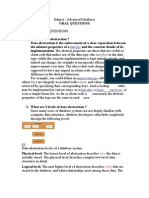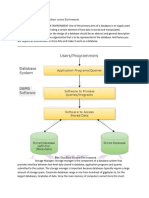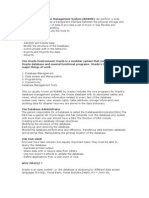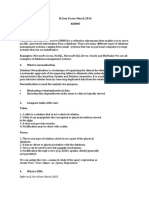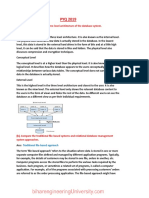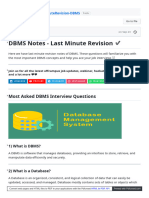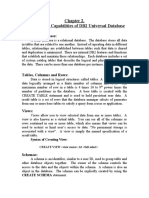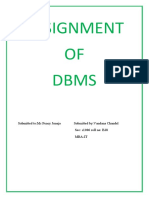DBMS Solution Paper 2009
DBMS Solution Paper 2009
Uploaded by
Kaushik SadhuCopyright:
Available Formats
DBMS Solution Paper 2009
DBMS Solution Paper 2009
Uploaded by
Kaushik SadhuCopyright
Available Formats
Share this document
Did you find this document useful?
Is this content inappropriate?
Copyright:
Available Formats
DBMS Solution Paper 2009
DBMS Solution Paper 2009
Uploaded by
Kaushik SadhuCopyright:
Available Formats
Solved Question Paper BCA302
Database Management System
Gujarat University TY BCA Solved Question Papper of April 2009 : Total Marks 70 Duration : 3 hrs 1 Answer the following. 14 (A) Answer the following in 'SQL' (Any five) 10 3 Explain GROUP BY clause within SELECT statement. Answer: The group by clause is generally used when you have attribute columns combined with aggregate functions in the SELECT statement. 4 Explain ADD_MONTHS, LAST_DAY function with an example. Answer: ADD_MONTHS Adds a number of months to a date; useful for adding months or years to a date. SYNTAX ADD_MONTHS (date_value, n) EXAMPLE SELECT P_CODE, P_INDATE, ADD_MONTHS (P_INDATE,24) FROM PRODUCT ORDERBY ADD_MONTHS (P_INDATE,24); LAST_DAY Returns the date of the last day of the month given in a date SYNTAX LAST_DAY (date_value) EXAMPLE SELECT EMP_LNAME, EMP_FNAME, EMP_HIRE_DATE FROM EMPLOYEE ORDERBY EMP_HIRE_DATE >= LAST_DAY (EMP_HIRE_DATE)-7; 6 Explain Primary key and Foreign key constraint with an example. Answer: Primary key: A candidate key selected to uniquely identify all other attribute value in any given row can not contain null entries. Foreign key: An attribute (or combination of attributes) in one table whose values must either match the primary key in another table or be null. 2 Answer the following (Any seven). 14 1 Define a Table and list any 3 characteristics of a Relational Table. Answer: Table: A table is perceived as a two dimensional structure composed of rows and columns. Characteristics of relational table: Each table row represents a single entity occurrence within the entity set. Each table column represents an attribute, and each column has a distinct name. Each row/column intersections represent a single data value. 2 Define Super key and Candidate key. Answer: Super key:
An attribute (or combination of attributes) that uniquely identifies each row in a table. Candidate key: A minimal super key. A super key that dose not contain a subset of attributes that is itself a super key. 3 What is referential integrity rule? Answer: If the foreign key contains either matching values or null exhibit referential integrity. In other word referential integrity means that if the foreign key contains a values, that value refers to an existing valid tuple (row) in another relation. 4 Explain SELECT relational operator Answer: SELECT can be used to list all of the row values, or it can yield only those row values that match a specified criterion. 5 Define right and left outer joins Answer: Right outer joins In a pair of a tables to be joined, a right outer join yields all of the rows in the right table, including those that have no matching values in another table. Left outer joins In a pair of a tables to be joined, a left outer join yields all of the rows in the left table, including those that have no matching values in another table. 7 Explain 1:1 and 1:M relationship within the relational database. Answer: 1:1 relationship A retail companys management structure may require that each of it stores be managed by a single employee. In turn, each store manager, who is an employee, manages only a single store. Therefore, the relationship Employee manages Store is labeled 1:1. 1:M relationship A customer may generate many invoices, but each invoice is generated by only a single customer. The Customer generates Invoice relationship would also be labeled 1: M. 8 Define Homonyms and Synonym. Answer: Homonyms In a database context, the word homonyms indicate the use of the same attribute name to label different attributes. Synonym Synonym is opposite of a Homonym and indicates the use of different names to describe the same attribute. 3 Answer the following. 14 (A) Answer any one of the following. 7 1 What is Normalization? Define BCNF and 4NF. Answer: Normalization Normalization is a process for evaluating and correcting table structure to minimize data redundancies, there by reducing the likelihood of data anomalies. BCNF: Boyce Code Normal Form A special form of third normal form (3NF) in which every determinates I s a candidate key. A table that is in BCNF must be in 3NF. When a table contains only one candidate key, the 3NF and the BCNF are equivalent. 4NF: A table is in fourth normal form (4NF) when it is in 3NF and has no multiple sets of multivalued dependencies. The 4NF has following two rules:
- All attributes must be dependent on the primary key, but they must be independent of each other. - No row may contain two or more multivalued facts about an entity. (B) Answer the following (any one) 7 Explain Distributed Database and disributed processing with appropriate 1 diagrams. Answer: Distributed Database A logically related database that is stored over two or more physically independent sites. Disributed processing The activity of sharing (dividing) the logical processing of a database over two or more sites connected by a network. 2 Discuss the components of DDBMS with a diagram. Answer: Components of DDBMS Computer workstations that from the work system. The distributed database system must be independent of the computer system hardware. Network hardware and software components that reside in each workstation. The network components allow all sites to interact and exchange data. Communication media that carry the data from one workstation to another. The DDBMS must be communications-media-independent; that is, it must be able to support several types of communications media. The transaction processor (TP), which is the software component, found in each computer that requests data. The transaction processor receives and processes the applications data requests. The TP is also known as the application processor (AP) or the transaction manager (TM). The data processor (DP), which is the software components residing on each computer that stores and retrieves data located at the site. The DP is also known as the data manger (DM), a data processor may even be a centralized DBMS. 4 Answer the following. 14 (A) Answer any one of the following. 7 2 Discuss Hierarchical and Relational Data Models. Answer: Hierarchical Data Models The hierarchical model was developed in 1960 to manage large amounts of data for complex manufacturing project such as the Apollo rocket that landed on the moon in1969. Its basic logical structure is represented by an upside down tree. The hierarchical structure contains levels or segments. A segment is the equivalent of a file systems record type. Within the hierarchy the top layer (the root) is perceived as the parent of the segment directly beneath it. Relational Data Models The relational model was introduced by E.F.Codd in 1970 in his landmark paper A relational model of data for large shared Databanks. The relational model represented a major breakthrough for both users and designers. To use an analogy, the relational model produced an automatic transmission database to replace the standard transmission database that preceded it. It conceptual simplicity set the stage for a genuine database revolution. The relational data model is implemented through a very sophisticated relational database management system (RDBMS). 5 Answer the following (Any two). 14 What is Transaction? List and discuss ACID properties of a Transaction. Define 1 Transaction Log and Whatis its function. Answer: Transaction
In a database terms, a transaction is any action that reads from and / or writes to a database. ACID properties of a Transaction Atomicity Atomicity requires that all operations of a transaction be completed; if not, the transaction is aborted. If a transaction T1 has four SQL requests, all four requests, must be successfully completed, other wise, the entire transaction is aborted. Consistency: Consistency indicates the permanence of the databases consistent state. When a transaction is completed, the database reaches a consistent state. Isolation: Isolation means that the data used during the execution of a transaction cannot be used by a second transaction until the first one is completed. This property is particularly useful in multiuser database environments because several different users can access and update the database at the same time. Durability: Durability ensures that once transaction changes are done, they cannot be undone or lost, even in the event of a system failure. Serializability: Serializabilty ensures that the concurrent execution of several transactions yields consistent results. This property is important in multiuser and distributed database, where multiple transactions are likely to be executed concurrently. Naturally, if only a single transaction is executed, serializability is not an issue. Explain types of locks in detail. Database level lock: A type of lock that restricts database access to only the owner of the lock. It allows only one user at a time to access the database. Successful for batch processes, but unsuitable for online multiuser DBMSs. Page level lock: In this type of lock, the database management system will lock an entire disk page, or section of a disk. A disk page can contain data for one or more rows and from one or more tables. Table level lock: A locking schema that allows only one transaction at a time to access a table. A table level lock locks an entire table, preventing access to any row by transaction T2 while transaction T1 is using the table. Row level lock: A comparatively less restrictive database .
You might also like
- AZ-900T00 Microsoft Azure Fundamentals-02Document43 pagesAZ-900T00 Microsoft Azure Fundamentals-02Ironman75% (4)
- First Normal Form (1NF) : 1. What Do You Understand by Relational Algebra?Document10 pagesFirst Normal Form (1NF) : 1. What Do You Understand by Relational Algebra?drbhaveshNo ratings yet
- ADBMSDocument19 pagesADBMSSahil ParmarNo ratings yet
- DBMS Unit 3 NotesDocument29 pagesDBMS Unit 3 Notesashwanimpec20No ratings yet
- Lab Internal QuestionsDocument11 pagesLab Internal Questionstejasrigurram135No ratings yet
- Some Important QuesDocument14 pagesSome Important QuesSakib MuhaiminNo ratings yet
- Basic DBMS Interview QuestionsDocument6 pagesBasic DBMS Interview Questionsashish kumarNo ratings yet
- Advanced Database System Set 1: Third Normal Form (3NF) and Boyce-Codd Normal Form (BCNF)Document17 pagesAdvanced Database System Set 1: Third Normal Form (3NF) and Boyce-Codd Normal Form (BCNF)Jimmy JackNo ratings yet
- Cs6302 Dbms 2mark & 16 MarkDocument5 pagesCs6302 Dbms 2mark & 16 MarkSunny Ravindra ChawanNo ratings yet
- Relationaldatabase Management System MaterialDocument37 pagesRelationaldatabase Management System MaterialbalajipalaNo ratings yet
- Dbms PresentationDocument50 pagesDbms PresentationbalagopalbhallamudiNo ratings yet
- DBE - Model Question-1Document15 pagesDBE - Model Question-1Mantu MeherNo ratings yet
- DBMS Interview Theory QuestionsDocument6 pagesDBMS Interview Theory QuestionsSai Venkat GudlaNo ratings yet
- Introduction To OracleDocument8 pagesIntroduction To Oracleapi-3805308No ratings yet
- Refer To Q. No 4 From March 2015Document13 pagesRefer To Q. No 4 From March 2015Jyotsna SuraydevaraNo ratings yet
- RDBMS Refined MaterialDocument40 pagesRDBMS Refined Materialssiva21No ratings yet
- Dbms Solved QuestionsDocument18 pagesDbms Solved Questionslabdhigandhi2003No ratings yet
- 1 RDBMS ConceptsDocument45 pages1 RDBMS ConceptsMeonline7No ratings yet
- Oral Questions Dbms LabDocument6 pagesOral Questions Dbms LabbondageshwetaNo ratings yet
- Dbms Pyq Solution 2019Document13 pagesDbms Pyq Solution 2019swetaNo ratings yet
- 5.how Many Instances of An Abstract Class Can Be Created-4 Class 1byte 6Document20 pages5.how Many Instances of An Abstract Class Can Be Created-4 Class 1byte 6Krishna ganthNo ratings yet
- WHERE Tbl1.Column1 Tbl2.Column2: Stored Procedure UDFDocument4 pagesWHERE Tbl1.Column1 Tbl2.Column2: Stored Procedure UDFswapnilNo ratings yet
- A) Data TypesDocument16 pagesA) Data TypesRaghu Ram AllaNo ratings yet
- DMS AssignmentDocument17 pagesDMS AssignmentBasit KhanNo ratings yet
- Unit 2Document82 pagesUnit 2suryabirru1No ratings yet
- DBMS Interview Questions and AnswersDocument5 pagesDBMS Interview Questions and AnswersUdit TrivediNo ratings yet
- Github Com Aman0046 LastMinuteRevision DBMSDocument8 pagesGithub Com Aman0046 LastMinuteRevision DBMSGEN GENTLE INFAMOUSNo ratings yet
- Question Bank For ETE DBMSDocument11 pagesQuestion Bank For ETE DBMSadarshsingh1203No ratings yet
- MYSqlDocument17 pagesMYSqlPrashantNo ratings yet
- Exploring The Capabilities of DB2 Universal DatabaseDocument5 pagesExploring The Capabilities of DB2 Universal DatabaseAbdul Kadir ArsiwalaNo ratings yet
- Assignment OF DbmsDocument13 pagesAssignment OF DbmsVandy CoolNo ratings yet
- DDBMS-Chapter-4-SE-LectureNote (Version 1)Document11 pagesDDBMS-Chapter-4-SE-LectureNote (Version 1)davegerimNo ratings yet
- Question 1 To 7 Notes (Defn)Document14 pagesQuestion 1 To 7 Notes (Defn)Khin MyintNo ratings yet
- CS619 Final Project Viva QuestionsDocument13 pagesCS619 Final Project Viva QuestionsAbDur ReHman RaeEs100% (2)
- TashitaDocument21 pagesTashitamk3342542No ratings yet
- Interview Questions and Answers On Database BasicsDocument13 pagesInterview Questions and Answers On Database BasicsDebsankha GhoshNo ratings yet
- Dbms March 2012Document17 pagesDbms March 2012Adarsh AmzeNo ratings yet
- Dbms 15 MarksDocument44 pagesDbms 15 MarksIndia RaniNo ratings yet
- Unknown PDFDocument44 pagesUnknown PDFCoding LifeNo ratings yet
- Dbms File Format ShubhamDocument10 pagesDbms File Format Shubhamshubhamdhamija9No ratings yet
- Dbms NotesDocument10 pagesDbms Noteslavzzz2255No ratings yet
- MCS023Document43 pagesMCS023Ls PayneNo ratings yet
- Interview Questions: Database: 1. Question: What Are The Difference Between Functions and Procedures?Document4 pagesInterview Questions: Database: 1. Question: What Are The Difference Between Functions and Procedures?satishms10No ratings yet
- Dbms Lab VivaDocument7 pagesDbms Lab VivaAngelin Jeyaseeli DNo ratings yet
- DbmsDocument35 pagesDbmsMadhur MalikNo ratings yet
- SQL Interview QnsDocument19 pagesSQL Interview QnsJaved GouryNo ratings yet
- Unit 1-2mark: 1. Define Database Management SystemDocument15 pagesUnit 1-2mark: 1. Define Database Management SystemShanthi GanesanNo ratings yet
- ADBMS Chapter OneDocument21 pagesADBMS Chapter OneNaomi AmareNo ratings yet
- MS SQLDocument95 pagesMS SQLmanu424No ratings yet
- Assignment Set - 1 Database Management System (DBMS and Oracle 9i)Document28 pagesAssignment Set - 1 Database Management System (DBMS and Oracle 9i)Vinayak PrabhuNo ratings yet
- SQL Crash Course PDFDocument24 pagesSQL Crash Course PDFArun PanneerNo ratings yet
- Document 1Document6 pagesDocument 1GauravNo ratings yet
- DBMS Solved QPDocument12 pagesDBMS Solved QPgofeve3664No ratings yet
- Complete Download of Accounting Information Systems 8th Edition Hall Solutions Manual Full Chapters in PDFDocument41 pagesComplete Download of Accounting Information Systems 8th Edition Hall Solutions Manual Full Chapters in PDFkhemislemou100% (8)
- Data Base Administration Level IV: Shashemene Poly Technique CollegeDocument25 pagesData Base Administration Level IV: Shashemene Poly Technique CollegeMahdi ZeynNo ratings yet
- Unit 1-2mark: 1. Define Database Management SystemDocument15 pagesUnit 1-2mark: 1. Define Database Management SystemAishu elangoNo ratings yet
- Oracle Performance Tuning Interview QuestionsDocument7 pagesOracle Performance Tuning Interview QuestionsJean Jacques Nkuitche NzokouNo ratings yet
- DBMS Questions &SQL QueriesDocument10 pagesDBMS Questions &SQL Queriesprecious123No ratings yet
- Basics of SQLDocument16 pagesBasics of SQLNethala SwaroopNo ratings yet
- Gross Domestic Product 2013: (Millions of Ranking Economy US Dollars)Document4 pagesGross Domestic Product 2013: (Millions of Ranking Economy US Dollars)Kaushik SadhuNo ratings yet
- Sims ReeDocument11 pagesSims ReeKaushik SadhuNo ratings yet
- II Semester B.C.A. Examination, May/June 2010 (Y2K7 Scheme) Computer Science BCA 203: Numerical and Statistical MethodsDocument3 pagesII Semester B.C.A. Examination, May/June 2010 (Y2K7 Scheme) Computer Science BCA 203: Numerical and Statistical MethodsKaushik SadhuNo ratings yet
- Visual Basic ViVa QuestionDocument7 pagesVisual Basic ViVa QuestionKanchan Khurana80% (5)
- Chapter 1Document8 pagesChapter 1Kaushik SadhuNo ratings yet
- PMIS ReportsDocument2 pagesPMIS ReportsChandan Kumar0% (1)
- Principles of Dbms Mock TestDocument6 pagesPrinciples of Dbms Mock TestAkshayMahajanNo ratings yet
- UNIT 05 - Data Science - FinalDocument36 pagesUNIT 05 - Data Science - FinalMukul RaghuwanshiNo ratings yet
- EAM - Tables and Data StructuresDocument70 pagesEAM - Tables and Data StructuresAhmed ForsanNo ratings yet
- CH 04Document30 pagesCH 04ahmadNo ratings yet
- Finals (Quiz)Document4 pagesFinals (Quiz)Lenjoe SuazoNo ratings yet
- BHA-FPX4106 - Nadhirah Lutchminarain - Assignment 2Document6 pagesBHA-FPX4106 - Nadhirah Lutchminarain - Assignment 2Nadhirah De WetNo ratings yet
- DataSunrise InfoDocument2 pagesDataSunrise Infomahesh malveNo ratings yet
- Strategic Alignment ITIL PerspectiveDocument6 pagesStrategic Alignment ITIL Perspectivegtbezerra9884No ratings yet
- Puting Tubig - DecDocument37 pagesPuting Tubig - DecAngelika CalingasanNo ratings yet
- Unit - 6 - Transaction and Recovery ManagementDocument96 pagesUnit - 6 - Transaction and Recovery ManagementAaliya SharmaNo ratings yet
- 2.1 Waterfall Process ModelDocument16 pages2.1 Waterfall Process ModelPalash ChakrabortyNo ratings yet
- Commonly Asked MongoDB Interview Questions (2023) - InterviewbitDocument21 pagesCommonly Asked MongoDB Interview Questions (2023) - InterviewbitSagar ChaudhariNo ratings yet
- Analisis SWOT Terhadap Layanan Kardiovaskular Eka Hospial PekanbaruDocument20 pagesAnalisis SWOT Terhadap Layanan Kardiovaskular Eka Hospial PekanbaruTitin IndrayaniNo ratings yet
- Day 3.2 - UML (Unified Modeling Language) - Case StudyDocument13 pagesDay 3.2 - UML (Unified Modeling Language) - Case Studyvthh94No ratings yet
- Create and Update The WPM in ERP and SCM: Master Change ImmediatelyDocument10 pagesCreate and Update The WPM in ERP and SCM: Master Change ImmediatelyBIROJI VENKAT RAMANANo ratings yet
- Assignment 6 - ETL For Accumulating Snapshot Enterprise Data WarehouseDocument2 pagesAssignment 6 - ETL For Accumulating Snapshot Enterprise Data WarehouseFastvilet netNo ratings yet
- 11 - Odi CDC GGDocument20 pages11 - Odi CDC GGMaheshBirajdarNo ratings yet
- E159212-1661016760460-180662-Unit 04 - DDD - Assingment - (Ishanka - Anuruddha-00128205)Document60 pagesE159212-1661016760460-180662-Unit 04 - DDD - Assingment - (Ishanka - Anuruddha-00128205)AhamedNo ratings yet
- Important DBMS Questions For Final Exam: GgisolutionsDocument12 pagesImportant DBMS Questions For Final Exam: GgisolutionsDhirajBhaktaNo ratings yet
- DBMS Imp QNDocument24 pagesDBMS Imp QNShivam kumarNo ratings yet
- Standards Listing 2023Document10 pagesStandards Listing 2023kannadasNo ratings yet
- Requirements Engineering Processes: ©ian Sommerville 2006Document52 pagesRequirements Engineering Processes: ©ian Sommerville 2006drabdulsamathNo ratings yet
- DWDM Unit-2Document75 pagesDWDM Unit-2Arun kumar SomaNo ratings yet
- Unit-1: Introduction To Database: Project PresentationDocument88 pagesUnit-1: Introduction To Database: Project PresentationKarmashree Dhiren PatelNo ratings yet
- Database Views: CHAPTER 5 (6/E) CHAPTER 8 (5/E)Document8 pagesDatabase Views: CHAPTER 5 (6/E) CHAPTER 8 (5/E)Renata Elena Lechado VanegasNo ratings yet
- ETL - MANUAL TESTER - 6.11 YrsDocument4 pagesETL - MANUAL TESTER - 6.11 YrsAbinash MahalikNo ratings yet
- Erp Structure PDFDocument2 pagesErp Structure PDFJonathanNo ratings yet
- Oracle Database - System Identifier (SID) (Gerardnico)Document2 pagesOracle Database - System Identifier (SID) (Gerardnico)shuvo_ami24100% (1)


